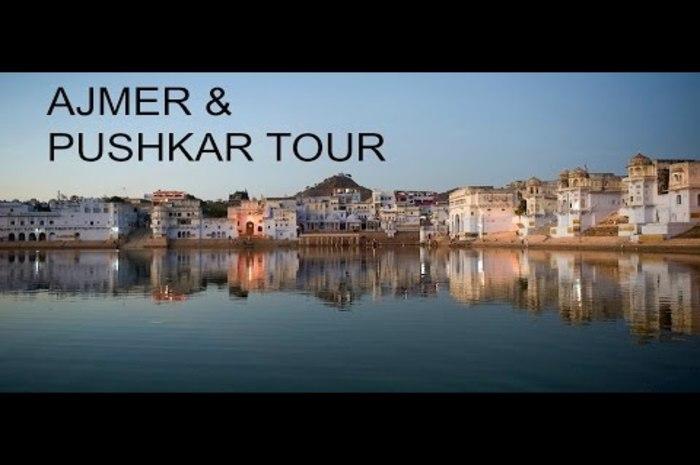(Same day) Jaipur Ajmer - Pushkar Tour
Jaipur-Ajmer(0N)--Pushkar(0N)--Jaipur(0N)--1D

Pick up from Jaipur, Drive to Ajmer after visiting Darga. Again drive towards Pushkar, in evening drive back to Jaipur at your desired location.
Ajmer:
Ajmer is the fifth largest city in the Indian state of Rajasthan and is the centre of the eponymous Ajmer District. According to the 2011 census, Ajmer has a population of around 551,360 in its urban agglomeration and 542,580 in the city. The city is located at a distance of 135 km from the state capital Jaipur and 391 km from the national capital New Delhi.Ajmer is surrounded by the Aravalli Mountains. It is a pilgrimage centre for the shrine of the Sufi Saint Khwaja Moinuddin Chishti and is also the base for visiting Pushkar (11 km), an ancient Hindu pilgrimage city, famous for the temple of Brahma. One can make excursions from Ajmer to the neighboring town of Pushkar known for the annual Pushkar Fair. Pushkar becomes a bustling and colorful fairground in the month of Kartik (October-November) when the annual Pushkar Fair is held. Hindu pilgrims come for the holy dip in Pushkar Lake, which is considered most on Kartik Poornima.The highlight of the fair is the Camel Fair, the trading of camels. Camels are bought, sold, decked up and paraded on the sand dunes, presenting a picturesque sight. The camel, horse and donkey races are events that draw huge attendance. The Pushkar Fair also brings together a large number of villagers from different parts of the state who display their traditional ware and also making the evenings colorful and festive with music and dance. There are about 400 temples in Pushkar famous as a spiritual tourist attraction, of which the most famous is the Jagat Pita Shri Brahma Mandir.It is said to be the only temple in the world dedicated to Brahma. Then there is the Savitri Temple overlooking the Pushkar Lake, the Varah temple, the Mahadeva Temple and the Ramvaikunth Temple. There are many ghats, which run down to the Holy Pushkar Lake whose waters are famed to wash the sins of a lifetime. Other places of interest around Ajmer are Mangliyawas, 26kms from Ajmer is famous for two 800 years old trees of a rare species, popularly known as 'Kalpa-Vriksha'. People visit this place through out the year but on dark moon day of 'Sravana' (also spelt as Shravana) thousands of people come to worship the trees. Beawar, 54kms from Ajmer is famous for the Badshahi procession festival held on the next day of Holi when people participate in large numbers and throw 'Gulal' on each other. Kishangarh, 27kms from Ajmer has one of the finest schools for miniature paintings during 18th century. Badnor, 80kms from Ajmer is best known for its 500 years old imposing fort. Pachewar, 90kms from Ajmer is a small village in Rajasthan, which is an ideal stopover for the tourists traveling between Ajmer and Jaipur. The lake at Pachewar attracts thousands of migratory birds in the winters, a sight mostly loved by tourists. We are taking reservations for one-way cab rides from Delhi to Ajmer. Let our experienced and knowledgeable drivers take you comfortably on your trip
Jaipur:
Founded in AD 1727 by Sawai Jaisingh II, Jaipur the capital of Rajasthan is popularly known as the Pink City with broad avenues and spacious gardens. The capital of Rajasthan, Jaipur is steeped in history and culture. Here the past comes alive in magnificent forts and palaces, blushed pink, where once lived the maharajas. The bustling bazaars of Jaipur, famous for Rajasthani jewellery, fabric and shoes, possess a timeless quality and are surely a treasure-trove for the shoppers. This fascinating city with its romantic charm takes you to an epoch of royalty and tradition. Jaipur has been laid according to the conventional nine-grid pattern that astrologers believe to be lucky, and which has been recommended in the ancient Indian treatise on architecture. Each grid consists of a square, and these have been planned so that, at the heart of the city is the City Palace. Spread around it, in rows, are public buildings, the residences of noblemen, the living and trading quarters of merchants and artisans. Straight, wide roads run through the city, while a high, crenellated wall that forms its defense is pierced with seven gateways that serve as entry points. Today, these walls may be more difficult to spot since the city has grown far beyond its original plan, but they are still there, proof that though Jaipur saw no great siege, it was more than adequately prepared for it. Jaipur’s architectural planning may have been ancient, but its execution was definitely modern. Best represented by the City Palace complex, it brought together all that was excellent in Rajput and Mughal architecture, creating a new tradition that found wide currency over much of north IndiaJaipur has much to offer visitors — everything from pageants and festivals to extraordinarily clad people, a wealth of handicrafts, a royal legacy of palaces, and sightseeing — that will occupy their time. However, should the visitors simply choose to walk around the streets of the old city instead, they will not regret it. All of Jaipur is an architectural gem, and no scheduled sight seeing can even hope to do justice to this rare city.